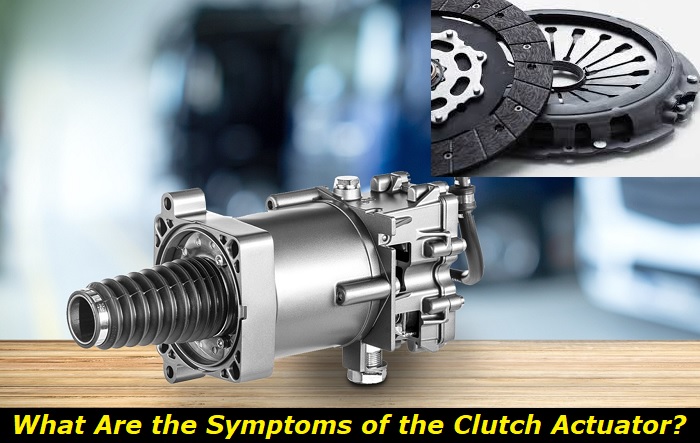A bad clutch actuator would spring a bunch of symptoms that'll ruin your day. It always starts with the check engine light, and you'll also notice symptoms such as difficulty shifting gears, inconsistent clutch engagement, clutch slippage, and erratic clutch release.
To solve the issue of bad clutch actuator symptoms, you need to start with a proper diagnosis. Depending on the severity of the problems, the clutch actuator may require adjustment, repair of specific components, or complete replacement.

What Is a Clutch Actuator and What Does It Do
If you drive with a manual transmission, then you've got a clutch actuator. It is responsible for engaging and disengaging the clutch allowing for smooth gear transitions and a smooth transfer of power to the wheels.
The clutch actuator works based on the electrical signals received from the vehicle's control system. When the driver presses down on the clutch pedal, the actuator gets the signal and disengages the clutch.
With the clutch disengaged, the transmission of power from the engine to the transmission is interrupted. This allows the driver to switch between gears smoothly. And as the clutch pedal is released, the clutch actuator gets another signal to re-engage the clutch. This enables the power to flow from the engine to the transmission once again.
Basically, the clutch actuator is the middle man so to speak between the clutch pedal and the mechanical operation of the clutch itself. And what it does is, it facilitates the engagement and disengagement of the clutch.
Bad Clutch Actuator Symptoms
As you know the clutch actuator is a vital part of a manual transmission system. And any underlying issues with the clutch actuator will lead to various bad clutch actuator symptoms. By identifying these symptoms, you can take the necessary steps toward addressing the problems.
Here are some common bad clutch actuator symptoms that you need to keep an eye out for:
1) Warning Lights
All modern vehicles equipped with an electronic system will trigger warning lights when something is wrong. And if your clutch actuator is failing, warning lights will pop up in your dash. Usually, it is the transmission warning light or another variant of that warning light that pops up when your clutch actuator fails.
The transmission warning light can pop up due to any problem within the transmission. So, to find out the exact cause and whether the problem is with the clutch actuator, you need to run a proper diagnosis. Connecting a scanner and reading the codes is the easiest way.
Whether it is the clutch actuator or not, when there warning lights popping up in your dash, you need to get your ride diagnosed and take necessary action towards solving the problem promptly.
2) Difficulty Shifting Gears
Difficulty shifting gears is one of the primary symptoms of a bad clutch actuator. When your clutch actuator fails, your clutch fails to engage and disengage smoothly. So, you may experience resistance or hear a grinding noise when pressing down on your clutch pedal. This will only make it harder to shift gears, but it could also end up damaging your transmission.
As the clutch actuator fails to properly engage or disengage the clutch, it causes the gears to clash, making it hard to find the appropriate gear position. Keep an eye out for resistance and unusual noises when shifting gears.
3) Clutch Slippage
This is another common symptom that you'd notice if your clutch actuator is faulty. Clutch slippage occurs when your clutch is not fully engaged or disengaged. This obstructs the transfer of power from the engine to the transmission.
As a result, you may notice a loss of acceleration, RPMs rising without a proportional increase in speed or even burning s burning smell emanating from the clutch. The burning smell is caused by the build-up of excess heat from a slipping clutch.
Sometimes when your clutch actuator fails, only a partial amount of power is transferred to the clutch. Without enough power, your clutch won't be able to fully engage causing slippage. If clutch slippage is not addressed quickly, it may cause damage to your clutch and other parts of your drivetrain.
4) Inconsistent Clutch Engagement
When your clutch actuator fails or starts to malfunction it can lead to unpredictable or irregular clutch engagement. Under normal circumstances, when you press down on your clutch pedal, your clutch would disengage allowing for a smooth transfer of gears. And you take your foot off the pedal, your cutch would re-engage.
As your clutch actuator fails, the exact spot in which your clutch engages and disengages will vary. So, as a driver, it becomes tough to predict the "sweet spot" when releasing the clutch pedal.
As a result of inconsistent clutch engagement, your clutch pedal may feel soft and spongy when you put your foot down. It may also cause difficulties shifting gears, jerky movement, engine stalling, and trouble starting the engine.
5) Erratic Clutch Release
Erratic clutch release refers to a situation where the clutch engages abruptly or with unpredictable force when the driver releases the clutch pedal. Normally, when you release the clutch pedal, the clutch smoothly re-engages to offer a smooth transfer of power from the engine to the transmission. However, with a faulty clutch actuator, the clutch release becomes erratic and inconsistent.
If you are facing this symptom due to a bad clutch actuator, it may lead to sudden jolts or jerks that'll make shifting gears harder. This can also lead to a lack of control over the vehicle's movement and an overall uncomfortable drive.
How To Fix A Bad Clutch Actuator
1) Diagnose The Problem
Familiarise yourself with the bad clutch actuator symptoms mentioned above. If you notice any of these symptoms, chances are you have a bad clutch actuator. Press and release the clutch pedal multiple times while paying attention to how it feels. If your clutch pedal feels spongy, soft, or even firmer than usual, it could indicate a problem with the clutch actuator.
The next step is a visual inspection of your clutch actuator. Look for any visible signs of damage, such as frayed wires, and loose connections. If your vehicle uses a hydraulic clutch system, also keep an eye out for hydraulic fluid leaks.
Another easy way to diagnose the problem is by reading the error codes using an OBD2 scanner. A bad clutch actuator will display a certain set of error codes. Refer to your owner's manual to accurately read those error codes.
2) Clutch Actuator Adjustment Or Repairs
In some cases, you don't need to totally scrap your clutch actuator when it fails. Some minor adjustments just might revive your clutch actuator. This may involve re-calibrating or repositioning the actuator to ensure proper clutch engagement and disengagement.
A clutch actuator adjustment will only be possible if you diagnose the problem at its early stages. If the issue is minor and the clutch actuator is in otherwise good condition, a clutch actuator adjustment is a cost-effective solution.
Performing an actuator adjustment on a clutch actuator is a complex task that typically requires specialized tools and expertise. So, it's recommended to visit a qualified mechanic to get your clutch actuator adjusted.
You might also be able to salvage your clutch actuator by replacing specific parts in the actuator. Actuator repair involves fixing specific components or circuits within the actuator and addressing any electrical or mechanical issues.
Again, a proper diagnosis will allow you to know whether repairing your clutch actuator is a viable option. Keep in mind an actuator repair can only be done with specific models and not all actuators can be repaired.
3) Clutch Actuator Replacement
If the clutch actuator is severely damaged or cannot be adjusted effectively, you won't have any other option but to go for a replacement. Even if your clutch actuator is repairable, sometimes it's cheaper and an overall better option to go for a clutch actuator replacement. A new clutch actuator will ensure reliable clutch operation and prevents further issues in the transmission system.
When you do replace your clutch actuator, always use OEM parts or high-quality alternatives. This ensures compatibility and optimal performance and will contribute to the clutch actuator's longevity and reliability.
How To Avoid Bad Clutch Actuator Symptoms
Just like every other part in your car, the best way to protect your clutch actuator is proper maintenance. For starters, if your clutch uses a hydraulic system, make sure there is an ample amount of fluid in the system. Also, make sure to use the fluid recommended by the manufacturer when topping off or replacing.
Whether your clutch works on a hydraulic system or not, regularly make sure to do a visual inspection. Look for any visible signs of damage, such as frayed wires, loose connections, or leaks in hydraulic systems. The sooner you find out any problems, the easier it is to fix them.
You should also make sure to keep your clutch actuator clean and free from debris. Dirt, dust, and grime can affect the actuator's performance, so regularly clean the area surrounding the clutch actuator.
Some driving habits also contribute to clutch actuator damage or wear. Avoid riding the clutch or unnecessarily keeping the clutch pedal partially depressed for extended periods. Proper clutch operation and avoiding clutch slippage will go a long way in increasing the lifespan of your clutch actuator.
About the authors
The CarAraC research team is composed of seasoned auto mechanics and automotive industry professionals, including individuals with advanced degrees and certifications in their field. Our team members boast prestigious credentials, reflecting their extensive knowledge and skills. These qualifications include: IMI: Institute of the Motor Industry, ASE-Certified Master Automobile Technicians; Coventry University, Graduate of MA in Automotive Journalism; Politecnico di Torino, Italy, MS Automotive Engineering; Ss. Cyril and Methodius University in Skopje, Mechanical University in Skopje; TOC Automotive College; DHA Suffa University, Department of Mechanical Engineering






Add comment